In the emergency room of the Infectious Diseases Department, Children’s Hospital 2 (HCMC), the sound of the heart rate monitor rang out regularly, mixed with the hurried footsteps of the nurses. Small beds were placed close together. On them, each child patient was struggling with fever, heavy breathing and tired eyes.
Common symptoms warn of dangerous diseases
On a hospital bed, NHB (7 years old, Tam Binh ward, Ho Chi Minh City) lay dozing after four days of severe dengue fever. The previous weekend, signs of the disease began to appear. Initially, the child had a high fever and headache, and was given fever-reducing medicine but the fever did not go down.
Too worried, the next morning, the parents immediately took their child to Children's Hospital 2 for examination. Here, the child was diagnosed with dengue fever and was ordered to be hospitalized for inpatient treatment for monitoring.
"At that time, the baby showed no signs of serious illness. Listening to the doctor's advice that 'dengue fever can progress unpredictably', I admitted my child to the hospital for easier monitoring. What I didn't expect was that after just one night, the baby's condition suddenly worsened, she became lethargic and then fainted. The baby was transferred to the Emergency Room for urgent intervention," Mr. NTT, B.'s father, recalled the moment of panic as he shook his daughter but she wouldn't wake up.
At this time, blood test results showed that the patient had a condition of blood concentration, low platelet count, and high liver enzymes. The child was quickly given an IV and closely monitored.
After two days in the Emergency Room, baby B. was still very tired and lethargic. Mr. T. and his wife took turns staying with their child, not daring to leave their side for even a moment. They had experienced this fear before when their eldest son was sick, but this time, the feeling of helplessness seemed to be doubled.
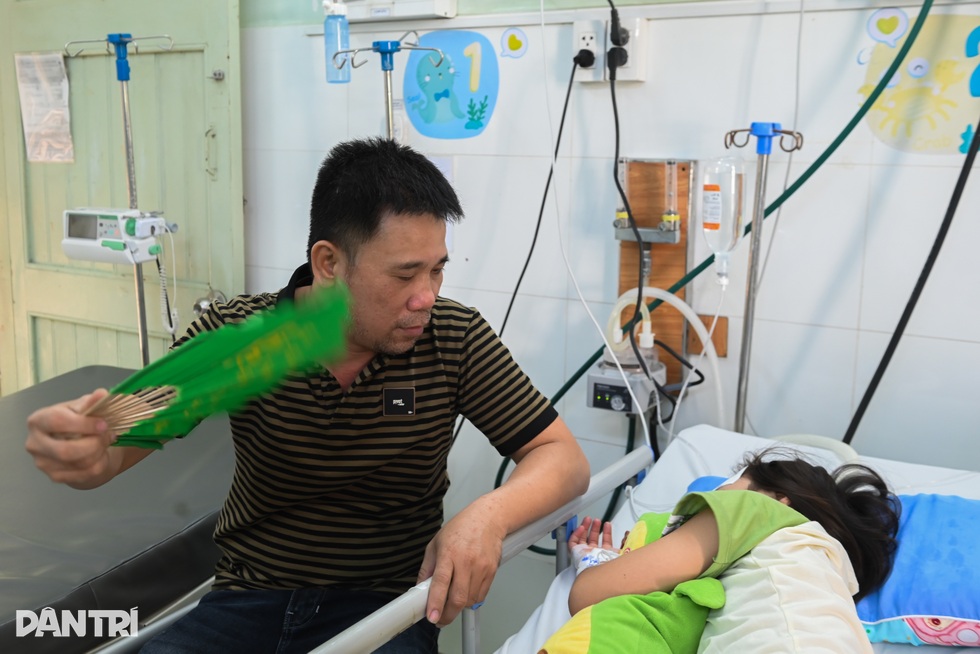
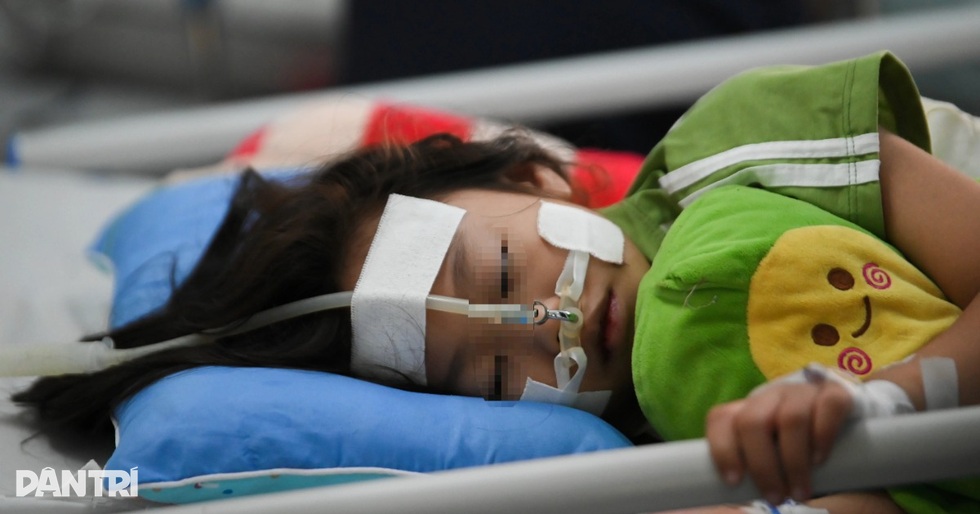
A few hospital beds away, another family is living with similar worries. Baby PCD. (3 years old, living in Phu My ward, Ho Chi Minh City) is also breathing heavily after 5 days of dengue fever.
Before that, the baby had a high fever for three days straight, coughed, vomited, and felt exhausted. Not seeing any unusual rash, the baby's family thought the baby just had a cold or a minor illness, and gave the baby fever-reducing medicine, but the baby's condition did not improve much.
After 3 days, D. began to show signs of worsening. Instead of crying, he gradually became lethargic and had difficulty breathing. At this time, the family took the child to a local hospital for examination. Here, the doctors discovered many abnormalities, suspected the child had dengue fever and advised the family to take the child to a higher-level hospital for treatment.
When admitted to Children's Hospital 2, the child was diagnosed with dengue fever, transferred to the Infectious Diseases Department and treated in the emergency room.

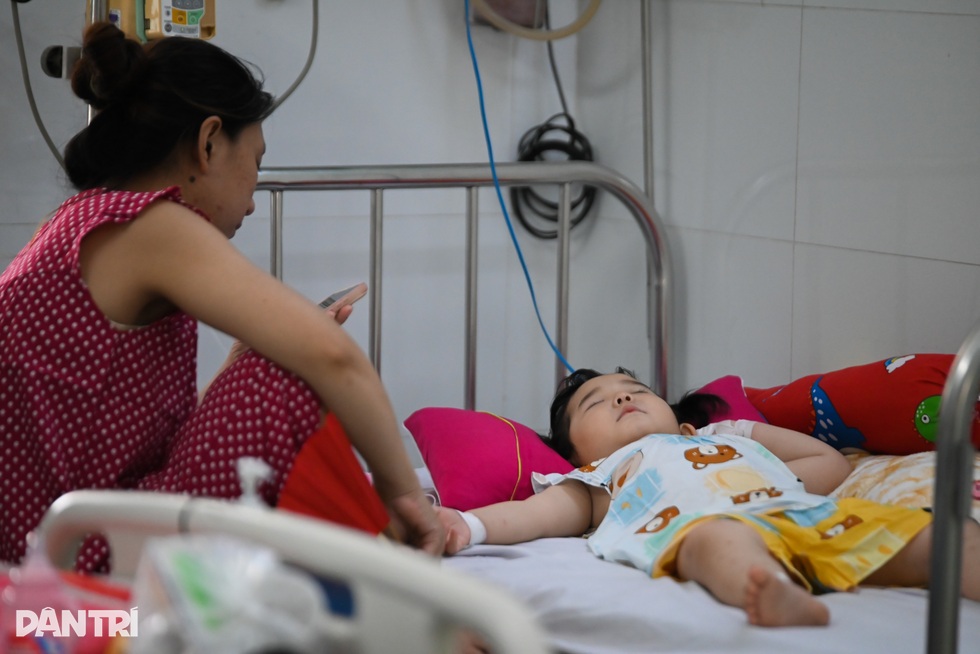
Risk of overlapping epidemics
Recently, Children's Hospital 2 recorded a 160% increase in the number of children with dengue fever and a 35% increase in hand, foot and mouth disease compared to the same period last year.
At the Infectious Diseases Department, there are currently nearly 60 children being treated for dengue fever at warning and severe levels, and more than 20 cases of hand, foot and mouth disease at level 2a or higher.
According to Dr. Nguyen Dinh Qui, Head of the Department of Infectious Diseases, the number of children hospitalized with these two diseases has doubled in the past two weeks. Meanwhile, the number of cases being monitored as outpatients is 4-5 times higher.
“What is worrying is the increase in the number of infected infants and children with underlying diseases. This is a high-risk group, prone to complications if not treated promptly,” said Dr. Qui.
The doctor also said that the weather in Ho Chi Minh City is in the transitional period, rainy and humid, creating favorable conditions for viruses and disease-carrying mosquitoes to thrive. In this context, both dengue fever and hand, foot and mouth disease are on the rise, making the risk of epidemics overlapping epidemics very high.
Faced with the complicated developments of the epidemic, the hospital has prepared a response plan since the beginning of the year. In addition to dividing the treatment areas in the Infectious Diseases Department for each specialized disease to avoid cross-infection, the hospital also has a plan to expand the number of beds when the number of cases suddenly increases, ensuring that there is no overload.
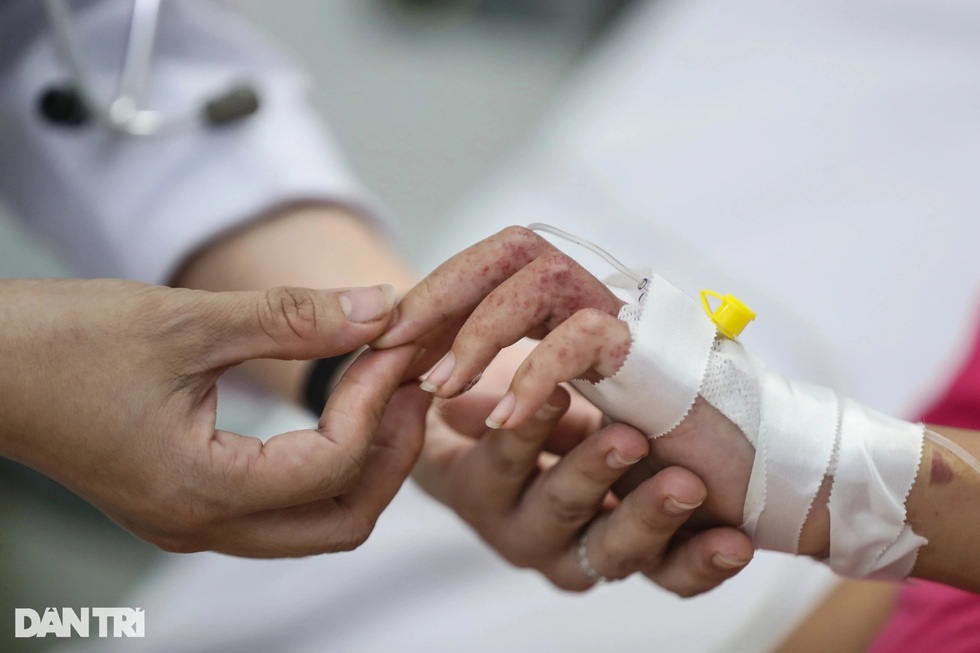
The hand of a child with dengue fever (Photo: Trinh Nguyen).
Dr. Truong Huu Khanh, Permanent Vice President of the Ho Chi Minh City Infectious Diseases Association, said that many cases of dengue fever were mistaken for common viral fever, leading to subjectivity, lack of close monitoring and treatment at home. This is the reason why patients are hospitalized late and are at risk of serious complications.
According to the expert, in fact, the fever reduction stage is the most dangerous time if not monitored medically . In addition, obesity and underlying diseases in general are alarming risk factors, causing dengue fever to progress more severely and complicatedly.
In addition to the acute treatment phase, Dengue fever also leaves long-term consequences, seriously affecting the physical, mental and quality of life of the patient.
After the critical stage, some children face prolonged fatigue and neurological dysfunction. Some cases require long-term rehabilitation such as physical therapy, nutritional monitoring and regular specialist check-ups to avoid future sequelae.
Meanwhile, hand, foot and mouth disease is an infectious disease caused by a virus, usually occurring in children under 5 years old. The disease is mainly transmitted through the digestive tract and direct contact with sick people through actions such as shaking hands, hugging, or kissing, with two peak periods usually falling in April-June and September-November.
When children have hand, foot and mouth disease, they often have a mild fever, fatigue, blister-like rash on the palms of the hands, soles of the feet, buttocks, and groin; mouth ulcers, sore throat, and excessive drooling. Most children with the disease will recover on their own.
However, in some cases, the disease can progress to severe symptoms such as high fever, labored breathing, shaking hands and feet, sudden sleep disturbances, and even cause complications affecting the brain, heart, etc. if not treated promptly.
According to the latest statistics from the Ho Chi Minh City Center for Disease Control (HCDC), from October 6 to October 12 (week 41), Ho Chi Minh City recorded 2,313 cases of dengue fever, an increase of 6.7% compared to the average of the previous 4 weeks. The total number of dengue fever cases accumulated from the beginning of 2025 to week 41 is 43,474 cases. Areas with high number of dengue fever cases per 100,000 people include Bac Tan Uyen, Bau Bang and Can Gio.
In week 41, Ho Chi Minh City also recorded 934 cases of hand, foot and mouth disease, an increase of 38.4% compared to the average of the previous 4 weeks. The total number of hand, foot and mouth disease cases accumulated from the beginning of 2025 to week 41 is 24,603 cases. Areas with high number of hand, foot and mouth disease cases per 100,000 people include Con Dao, Nha Be and Binh Tan.
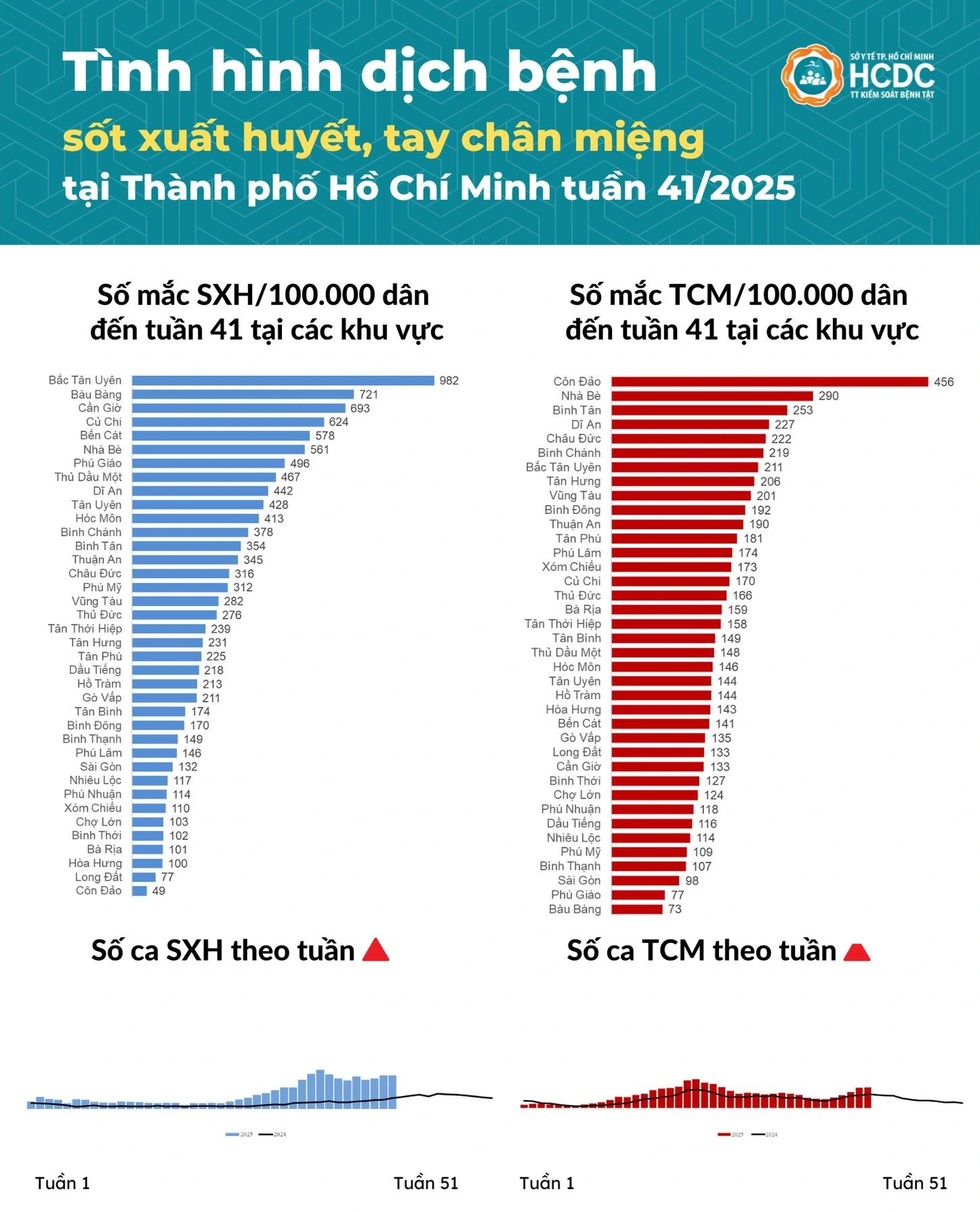
The situation of dengue fever and hand, foot and mouth disease in Ho Chi Minh City week 41 (Photo: HCDC).
Source: https://dantri.com.vn/suc-khoe/nguy-co-dich-chong-dich-mot-benh-vien-o-tphcm-san-sang-mo-rong-giuong-benh-20251018020630464.htm



![[Photo] Closing ceremony of the 18th Congress of Hanoi Party Committee](https://vphoto.vietnam.vn/thumb/1200x675/vietnam/resource/IMAGE/2025/10/17/1760704850107_ndo_br_1-jpg.webp)
![[Photo] General Secretary To Lam attends the 95th Anniversary of the Party Central Office's Traditional Day](https://vphoto.vietnam.vn/thumb/1200x675/vietnam/resource/IMAGE/2025/10/18/1760784671836_a1-bnd-4476-1940-jpg.webp)

![[Photo] Collecting waste, sowing green seeds](https://vphoto.vietnam.vn/thumb/1200x675/vietnam/resource/IMAGE/2025/10/18/1760786475497_ndo_br_1-jpg.webp)
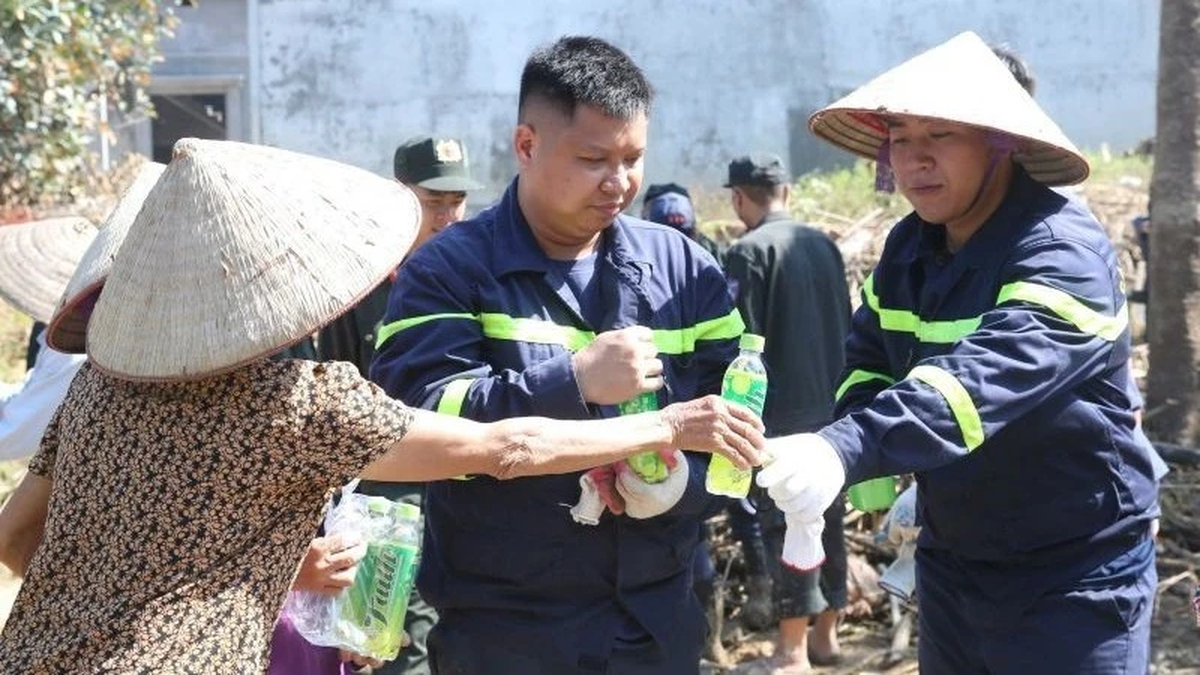





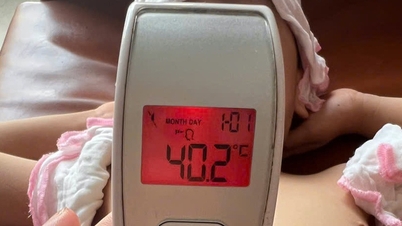
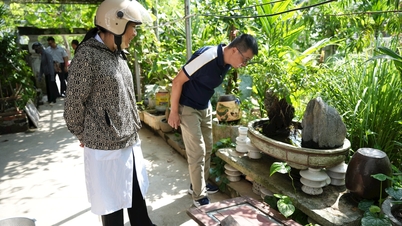

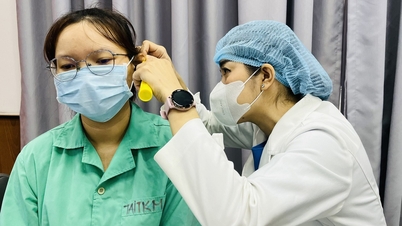



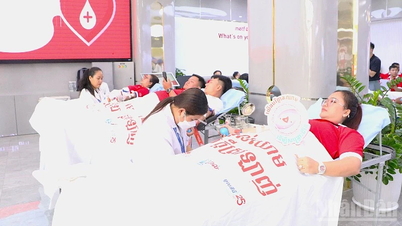




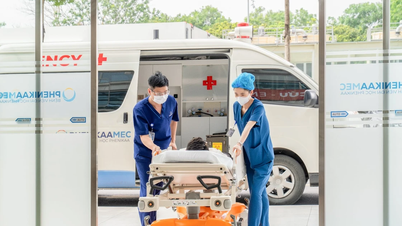





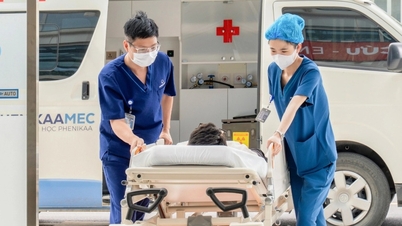























































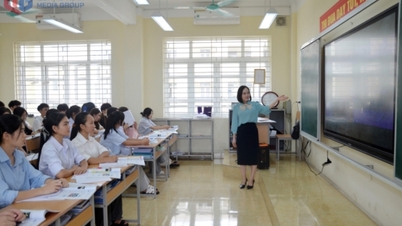

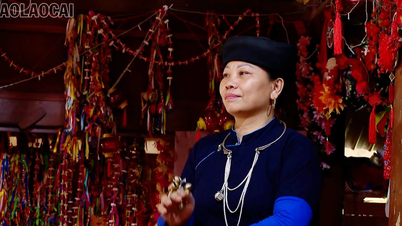















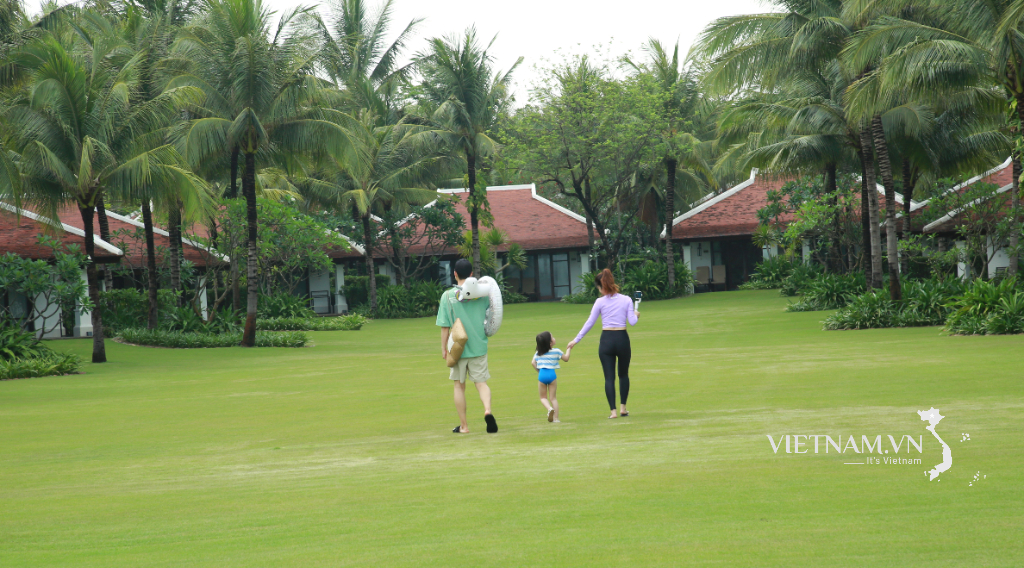
Comment (0)